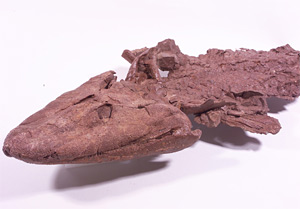 |
 |
 |
 Editorials | Environmental | May 2006 Editorials | Environmental | May 2006  
The Missing Link
 Ned Potter - ABC News Ned Potter - ABC News


| | "This is a fish that blurs the distinction between a fish and a land-living animal." |
High in the Canadian Arctic, a team of paleontologists has found what may be our great-great-great-great grandsomethings. They're fossils of ancient fish, 360 to 380 million years old... with the beginnings of legs.

Remember everything you learned as a child about how living things began in the oceans, and then, at some point, walked up on land? It was a terrific theory, but until now, only that. There were plenty of fossils of fish older than 400 million years, and plenty of legged animals younger than that, but not much in between.

Neil Shubin, a biologist at the University of Chicago, has been prospecting with his colleagues on Ellesmere Island, north of the Arctic Circle, since 1998, believing it would be a promising place to look for the missing link. In 2004, they hit pay dirt. Today in the journal Nature, Shubin, along with Ted Daeschler of Philadelphia's Academy of Natural Sciences and Farish Jenkins of Harvard, describe what they found.

The fossils are in remarkable shape. They look a bit like modern-day crocodiles. While they have fins, they have shoulder, elbow and wrist joints that would have been capable of supporting the animal's weight on land.

I talked with Shubin on the phone (he is understandably having a busy day), and he was filled with enthusiasm. "This is really cool," he said. "This is a fish that blurs the distinction between a fish and a land-living animal."

To give their find a name, the scientists went to the local council of elders in the Nunavut territory for a suggestion. Their answer: Tiktaalik (pronounced tic-TAL-lick), which means "large freshwater fish" in the Inuktitut language.

In an interview, Shubin said, "This is not some archaic branch of evolution. This is our branch of evolution. This is our wrist. This is the evolution of our neck. This is the evolution of our ear. This is very much our distant past." | 
 | |
 |



